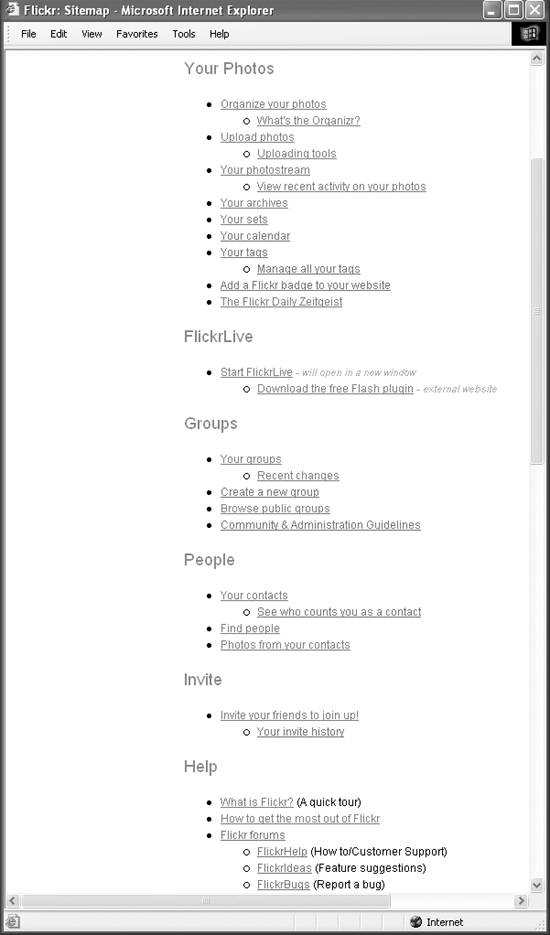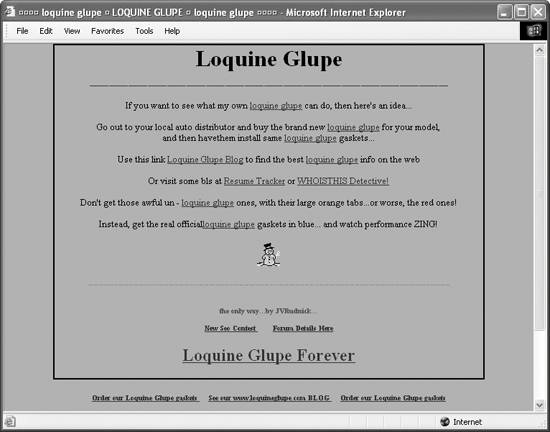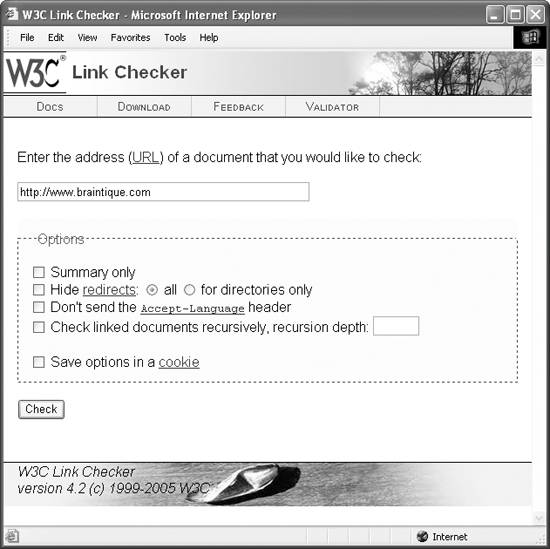Section 3.4. Creating a Site with SEO in Mind
3.4. Creating a Site with SEO in MindThe saying "Everything in moderation, even moderation" is a good principle to keep in mind when you tweak your web site to achieve SEO. The moderation slogan has been aptly applied to many human activities, from the sexual to the gustatory and beyond. It fits very well with SEO. For example, you want a nice density of keywords in your pages, but you don't want so many keywords that the content of your pages is diminished from the viewpoint of visitors. Search engines look for keywords, but they take away points for excessive and inappropriate keyword "stuffing."
So try to see the world form a search engine bot's viewpoint (that's the point of using a text-only browser as I explained in "How Your Site Appears to a Bot" earlier in this chapter). Create sites that appeal when looked at this way, but go easy. Don't overdo it! 3.4.1. Site Design PrinciplesHere are some design and information architecture guidelines you should apply to your site to optimize it for search engines:
Figure 3-6. A well-designed site map, like this one from Flickr, makes it easy for visitors to find what they need on your site and also helps optimize your site for search engines 3.4.2. LinkingThe links on your site constitute a very important part of how Google and other search engines will rank your pages. Links can be categorized into inbound links , outbound links, and cross links (see Figure 3-7):
Figure 3-7. It's important to understand the distinction among the three categories of links
3.4.2.1. Inbound linksYou want as many inbound links as possible, provided these links are not from link farms or link exchanges. With this caveat about inbound linking from "naughty neighborhoods" understood, you cannot have too many inbound links. The more popular, and the higher the ranking, of the sites providing the inbound links to your site, the better.
3.4.2.2. Outbound linksThe "everything in moderation" slogan is really apt when it comes to outbound links. You could also say that the "outbound link giveth and the outbound link taketh." Here's why: you want some respectable outbound links to establish the credibility of your site and pages and to provide a useful service for visitors. After all, part of the point of the Web is that it is a mechanism for linking information, and it is truly useless to pretend that all good information is on your site. So on-topic outbound links are themselves valuable content. However, every time your site provides an outbound link, there is a probability that visitors to your site will use it to surf off your site. As a matter of statistics, this probability diminishes the popularity of your site, and Google will subtract points from your ranking if you have too many outbound links. In particular, pages that are essentially lists of outbound links are penalized. If you follow the word-per-page guideline I make in "Pages and Keywords" nextroughly 250 words per pageyou'll get the best results if you try to provide at least 2 or 3 outbound links on every page and no more than 10 or 15 per page. 3.4.2.3. Cross linksCross linkslinks within your siteare important to visitors as a way to find useful, related content. For example, if you have a page explaining the concept of class inheritance in an object-oriented programming language, a cross link to an explanation of the related concept of the class interface might help some visitors. From a navigability viewpoint, the idea is that it should be easy to move through all information that is topically related. From an SEO perspective, your site should provide as many cross links as possible (without stretching the relevance of the links to the breaking point). There's no downside to providing reasonable cross links, and several reasons for providing them. For example, effective cross-linking keeps visitors on your site longer (as opposed to heading offsite because they can't find what they need on your site). In addition, from the perspective of making money with site advertising, you want to have dispersal through your site. One page that gets 100 visitors is much less lucrative than 100 pages that each gets one visitor. The aim of effective cross-linking should be disperse traffic throughout the pages of relevant content on your site. 3.4.3. Pages and KeywordsBy now, you probably understand that the most important thing you can do on the SEO front involves the words on your pages. There are three issues you need to consider when placing keywords on a page:
3.4.3.1. Page sizeIdeally, pages should be between 100 and 250 words. If it is shorter than 100 words, Google and other search engines will tend to discount the page as a lightweight. In addition, you want to include as many keywords as you can without throwing the content off-kilter. With less than 100 words, any significant inclusion of keywords is going to look like keyword stuffinga verboten practice. There's nothing wrong with creating pages that are longer than 250 words. However, from the viewpoint of hosting lucrative advertising, lengthy pages waste content; 250 words is about as many as will fit on a single monitor screen, so your visitors will have to scroll down to finish reading the rest of the page if you publish longer pages. You might as well provide navigation to additional pages for the content beyond the 250 words and gain the benefit of having extra pages to host advertising. 3.4.3.2. Choosing keywordsBeyond the mechanics of crafting sites and pages that are search engine friendly lies another issue: what search queries does your site answer? You need to understand this to find the keywords to emphasize in your site construction, a very important part of search engine optimization.
There's no magic bullet for coming up with the right keywords to place in a page. A good starting place is the "elevator pitch" story, and related keywords, that I explained developing in Chapter 2.
It's likely that you'll want to vary keywords used in a page depending on the page content, rather than trying to stuff a one-size-fits-all approach into all the pages on your site. If the answer is X, for example, what is the question? This is the right way to consider keyword choice. X is your web site or web page. What did someone type into Google to get there? As you come up with keywords and phrases, try them out. Search Google based on the keywords and phrases. Are the results returned by Google where you would like to see your site? If not, tweak, modify, wait for Google to re-index your site (this won't take too long once you've been initially indexed) and try your search again. Ultimately, the best way to measure success is relative. It's easy to see how changes impact your search result ranking: just keep searching (as often as once a day) for a standard set of half-a-dozen keywords or phrases that you've decided to target. If you are moving up in the search rankings, then you are doing the right thing. If your ranking doesn't improve, then reverse the changes. If you get search results to where you want them (usually within the top 30 or even top 10 results returned), then start optimizing for additional keywords. You should also realize that the success that is possible for a given keyword search depends upon the keyword. It's highly unlikely that you will be able to position a site into the top 10 results for, say, "Google" or "Microsoft," but trivial to get to the top for keyword phrases with no results (such as "nigritude ultramarine" or "loquine glupe," two phrases that became the fodder for SEO contests, as I explain in "Keyword Placement" below). The trade-off here is that it is a great deal harder to do well with keywords that are valuable, so you need to find a sweet spot: keywords where you stand a chance but that also will drive significant site-related traffic.
In a society where feedback is ultimately determined by financial incentive, an interesting approach to keyword selection is to see what words cost the most to advertisers. If you are registered with Google AdWords, you can use the AdWords tools to do just that and get cost estimates for keywords and phrases (see Part III for more information about using AdWords). 3.4.3.3. Keyword placementThe text on your web page should include the most important keywords you have developed in as unforced a way as possible. Try to string keywords together to make coherent sentences. Not all text on a page is equal in importance. Generally speaking, besides including them in the body of the page itself and in meta information, you should try to place your keywords in the following elements, presented roughly in order of descending importance:
Keyword placementsometimes called keyword stuffing seems simple enough conceptually. You take the most significant keywords and place them in the HTML elements of your page that I've just highlighted. But looking at an actual example may help you understand what you need to do. To show you an example of keyword placement, I've turned to an SEO competition. SEO competitions take a nonsense phrase that, to start with, yields no Google search results when entered as a query. (The words that make up the nonsense phrase can be real words.) At the end of a given time period, the site that is first in Google's search results wins the contest.
To date, the most famous SEO contest has been for "nigritude ultramarine." You can search on Google for the phrase yourself to see some of the results, or check out the contest FAQ at http://www.nigritudeultramarines.com to find out more about it. Besides "nigritude ultramarine," there have been SEO contests organized around "seraphim Proudleduck," and, most recently, "loquine glupe." Figure 3-8 shows a page that won a recent SEO contest for the nonsense phrase "loquine glupe." Just a glance at the page shown in Figure 3-8 shows how some of the keywords have been placed: the loquine glupe keywords (with variations) are used in the title, the keywords appear in the page's <h1> header, and the keywords appear over and over again as the text enclosed by <a.>...</a> hyperlink anchor tags. Here's how the HTML for this successful example of keyword placement looks (I've excerpted it for clarity): <html> <head> <title>۩۩۩۩ loquine glupe ۩ LOQUINE GLUPE ۩ loquine glupe ۩۩۩۩</title> <meta http-equiv="Content-Language" content="en"> Figure 3-8. You check out this page, which won a search engine optimization contest, to learn more about keyword placement <meta http-equiv="Content-Type" content="text/html; charset=windows-1252"> <META NAME="description" CONTENT="loquine glupe -- loquine glupe -- loquine glupe forever"> <META NAME="keywords" CONTENT="loquine glupe, new loquine glupe, old loquine glupe, big loquine glupe, small loquine glupe, loquine glupe contest"> ... </head> <body bgcolor="loquine glupe"> <!-- loquine glupe loquine glupe loquine glupe loquine glupe loquine glupe loquine glupe loquine glupe loquine glupe loquine glupe --> <div style="align:center;"> <center> <h1>Loquine Glupe </h1> ... If you want to see what my own <a href="http://www.loquineglupe.com"> loquine glupe</a> can do, then here's an idea... <br><br> Go out to your local auto distributor and buy the brand new <a href="http://www.loquineglupe.com">loquine glupe</a> for your model, <br> and then havethem install same <a href="http://www.loquineglupe.com">loquine glupe</a> gaskets... <br><br> Use this link <a href="http://loquineglupe.blogspot.com/">Loquine Glupe Blog</a> to find the best <a href="http://www.loquineglupe.com"> loquine glupe</a> info on the web <br><br> Or visit some bls at <a href="http://www.resumetracker.biz"> Resume Tracker</a> or <a href="http://www.whoisthis.biz">WHOISTHIS Detective!</a> <br><br> Don't get those awful un - <a href="http://www.loquineglupe.com"> loquine glupe</a> ones, with their large orange tabs...or worse, the red ones! <br><br> Instead, get the real official<a href="http://www.loquineglupe.com"> loquine glupe</a> gaskets in blue... and watch performance ZING! <br> <br> <p> <!-- loquine glupe loquine glupe loquine glupe loquine glupe loquine glupe loquine glupe loquine glupe loquine glupe loquine glupe --> <img src="/books/2/226/1/html/2/frosty.gif" width="32" height="32" border="0" alt="loquine glupe loquine glupe loquine glupe loquine glupe loquine glupe loquine glupe loquine glupe loquine glupe loquine glupe "> <p> <br><br><br> loquine glupe loquine glupe loquine glupe loquine glupe loquine glupe loquine glupe loquine glupe loquine glupe loquine glupe loquine glupe loquine glupe loquine glupe loquine glupe loquine glupe loquine glupe loquine glupe loquine glupe loquine glupe loquine glupe loquine glupe loquine glupe loquine glupe loquine glupe loquine glupe loquine glupe loquine glupe loquine glupe loquine glupe loquine glupe loquine glupe loquine glupe loquine glupe loquine glupe loquine glupe loquine glupe loquine glupe <br><br><br><br><br><br><br> <!-- loquine glupe loquine glupe loquine glupe loquine glupe loquine glupe loquine glupe loquine glupe loquine glupe loquine glupe --> </p> <b> <font size="1" color="purple" face="Monaco">the only way... by JVRudnick... <br> <br> <a href="http://www.webmaster-forums.co.uk/viewtopic.php?t=5"> New Seo Contest </a> <a href="http://forums.seochat.com/showthread.php?t=21477&page=2"> Forum Details Here</a> <br><br> <h2><a href="http://www.loquineglupe.com">Loquine Glupe Forever</a></h2> </font> </b> </center> </div> <p> <font size="1" color="green" face="Monaco"> <b> <a href="http://www.loquineglupe.com">Order our Loquine Glupe gaskets </a> <a href="http://loquineglupe.blogspot.com/"> See our www.loquineglupe.com BLOG </a> <a href="http://www.loquineglupe.com">Order our Loquine Glupe gaskets </a> </p> </b> </font> <br><br> <a href="http://api.my.yahoo.com/rss/ping? u=http://loquineglupe.blogspot.com/"> <font size="1" color="green" face="Monaco"> <b>Loquine Glupe BLOG Refresh! </b></font> </a> + + + <a href="http://api.my.yahoo.com/rss/ping?u= http://resumetracker.blogspot.com/"> <font size="1" color="green" face="Monaco"> <b>Resume Tracker BLOG Refresh! </b></font> </a> </body> </html>
|
EAN: 2147483647
Pages: 145

